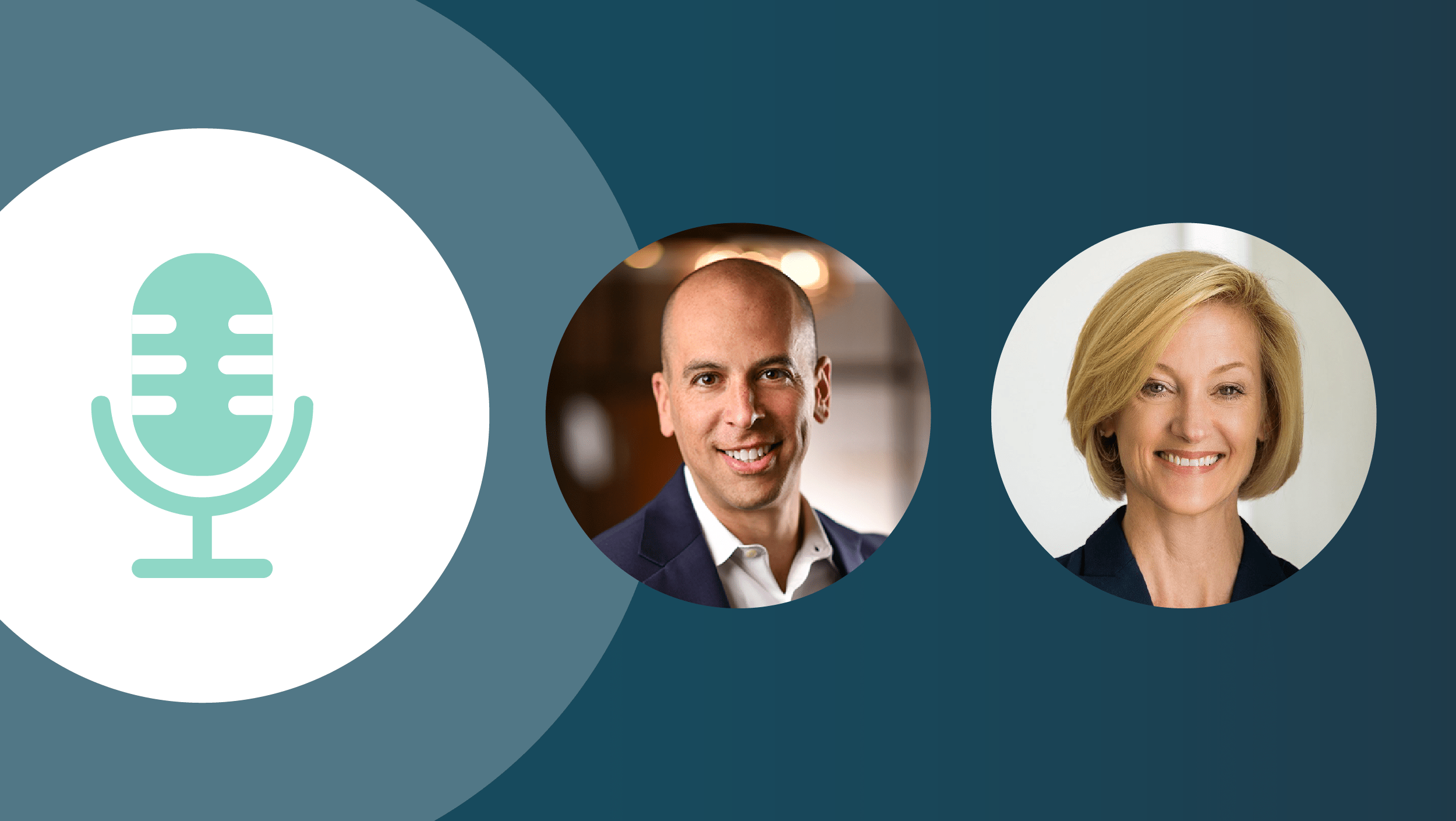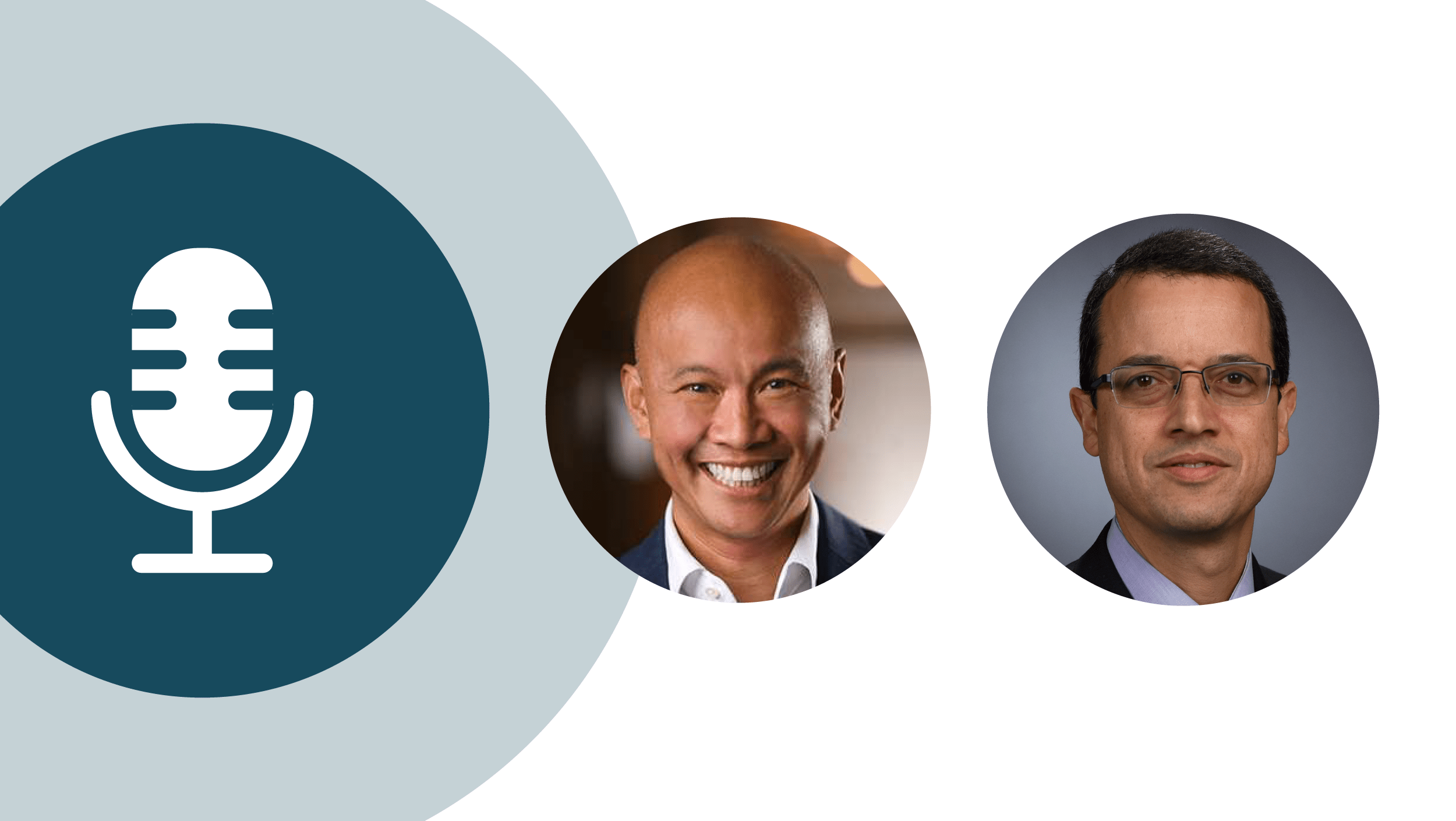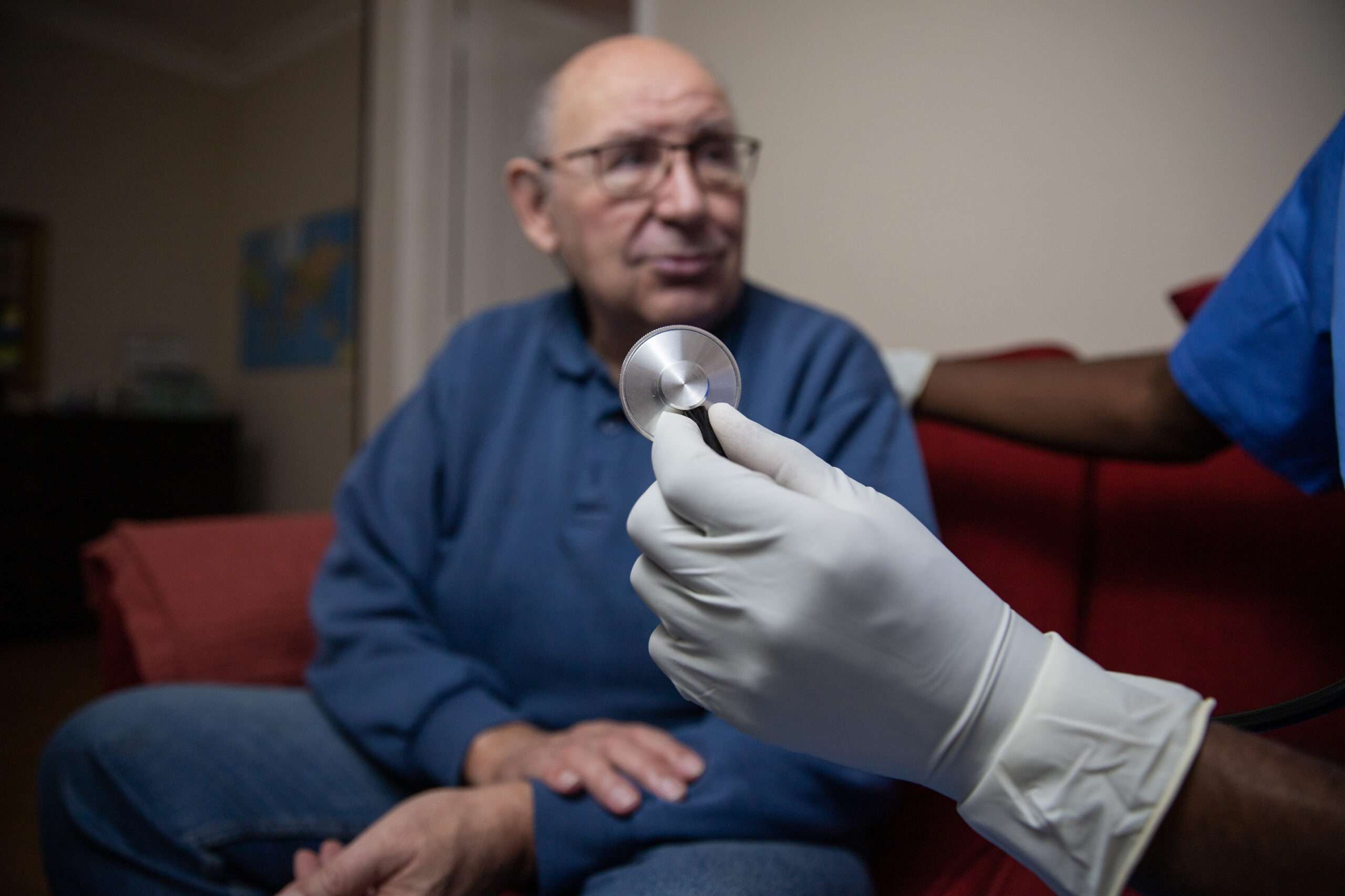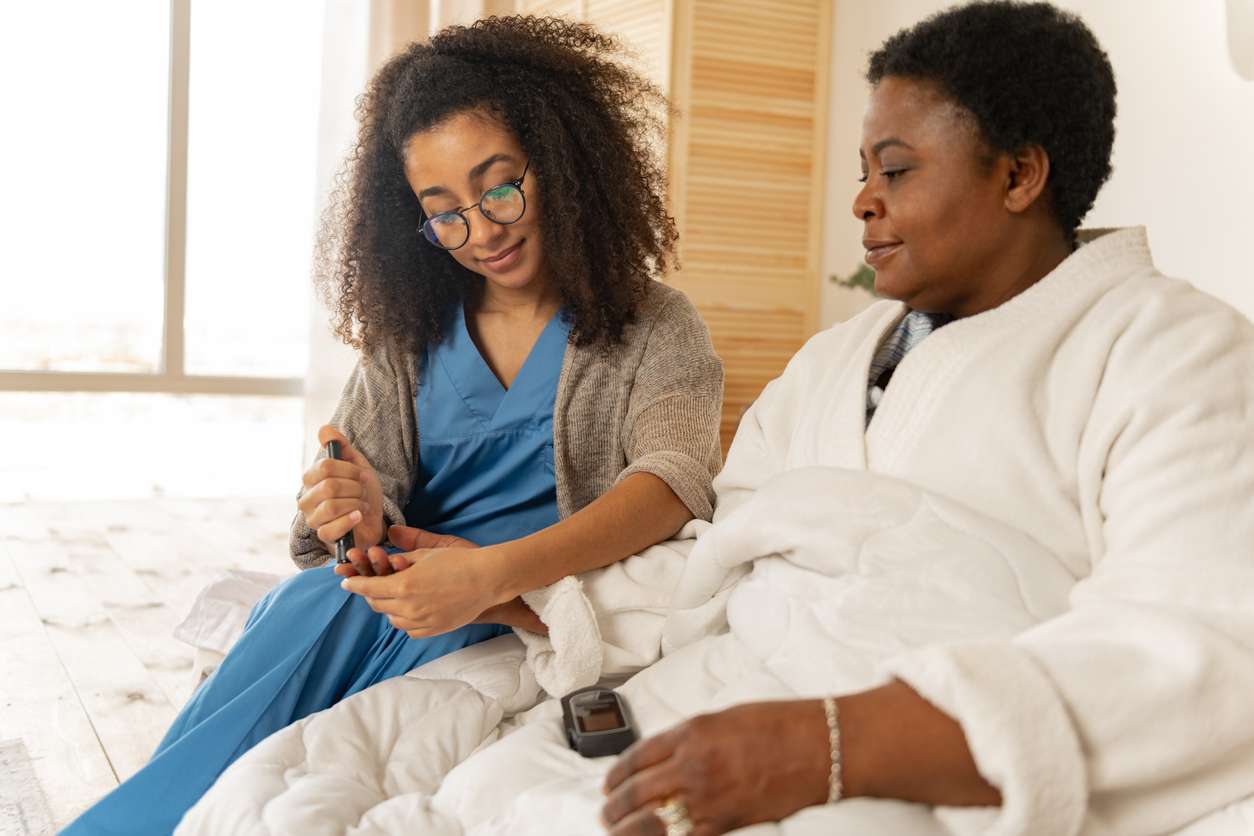Welcome to Beyond the Hospital: Voices in Advanced Care at Home, an interview series hosted by Chi-Cheng Huang, MD, Chief Medical Officer, and David Zimmerman, Chief Operating Officer at Inbound Health. Each episode features top voices in home-based healthcare who share the latest trends, innovations, and personal stories shaping the future of care delivery.
In this episode, we welcome Krista Drobac, Partner at Sirona Strategies, Executive Director of Moving Health Home, and a longtime policy leader and advocate for care in the home. Drawing on her decades of experience shaping federal healthcare policy, Krista discusses the challenges and triumphs surrounding the push for hospital-at-home and highlights how coalitions, health systems, and industry partners each play a critical role in driving change for the future of care delivery.
Dave Zimmerman: To kick us off, I’d love to hear about your background. What motivates you to stay in the public policy space?
Krista Drobac: It’s gotten a lot harder to get things done, but I still feel like we can. This is my 30th year in Washington. I came right after college, because you can accomplish a lot here. I worked on Capitol Hill, I worked at the Centers for Medicare & Medicaid Services (CMS), I led the Health Division for the National Governors Association––all to try and change a little piece of the world. While there’s a lot going on in the news, there are still people on the ground doing good things.
DZ: Throughout your time on the Hill, how have things changed in terms of what it takes to get policy enacted?
KD: When it started, it was all about making deals. Now, you have to have a coalition. As I tell people, you need to find your fellow travelers and go in as a group. It’s hard for one company or one organization to change things; that’s why we reach out to patient groups, provider groups, and business groups across the spectrum, so we go in together to say, “This impacts all of us and we need a change.” It really does take a village nowadays. It also takes more evidence. People want to know: Will this policy work? Is it going to raise costs? How will it impact patients? It’s less about knowing the right people, and more about having the story and the people around you to make an impact.
DZ: Is that part of the origin behind Moving Health Home?
KD: I’ve always been a big believer in coalitions. I started out in telemedicine. And if you think about it, one company isn’t going to be able to do the lift that’s necessary to, for instance, permit telemedicine and Medicare in perpetuity. We launched the Alliance for Connected Care in 2013 with the goal of securing coverage for telehealth services in Medicare. In 2020, we felt like it was finally going to happen. We’d already worked with the first Trump administration to remove the statutory barrier for remote monitoring, and we felt like telehealth was next. But then we thought, well, what happens if we get telehealth and remote monitoring? It still doesn’t create an in-home benefit. All you’re doing is paying for the tools––you’re not creating the care model.
So, we started Moving Health Home to extend hospital-at-home and raise awareness around all the things that can be done if we change the care models. For instance, how can we ensure that we don’t need a nurse in the home 24/7 for an SNF-at-home benefit? Patients and caregivers want to be home. There’s better care, more resilience, better mental health, no hospital-acquired infections––so many good things. I hope care-at-home becomes the future.
DZ: I’m biased, but I couldn’t agree more. What’s the temperature in Washington around home-based care?
KD: It’s always part of the conversation. The challenge is creating the right policy window. There are always a few major issues dominating the healthcare landscape, and it takes a significant amount of effort to break through the noise. But we’ve got a real crisis underway, and it takes groups like ours to keep pushing for attention, action, and solutions.
I do think it’s possible—we just need to seize every opening. For example, the $50 billion Rural Health Transformation Fund passed by Congress in the One Big Beautiful Bill (OBBB) mentioned care-at-home, as did the Physician Technical Advisory Committee to CMS. Any time Congress or a committee recognizes home-based care, we have to jump on it, amplify it, and make sure it’s heard. That’s how we build momentum and get people excited about this work.
DZ: Compared to the Biden administration, how have you seen interest in this space change under the second Trump administration?
KD: The difference has been striking. The team he has at CMS is deeply interested in tech-enabled care—things like remote monitoring, wearables, and tools that can measure blood pressure and other critical health indicators. They recognize the capacity challenges we’re facing with an aging population, so in that sense, we’re in a better position, but at the same time, we’re worse off with a secretary whose main focus is wellness and prevention. He talks a lot about chronic disease, which is important, but our emphasis is more on tertiary care, not prevention.
DZ: A lot of people are eager to see what happens with the extension of the hospital-at-home bill. Where do things stand now, and how do you expect to see this play out over the next few months?
KD: The challenge is that hospital-at-home is tied up with the year-end funding package, which has become the norm. Thirty years ago, we’d pass standalone bills—and something like this, which doesn’t cost money, could go through unanimous consent and pass without a vote. Today, almost everything is subject to a vote, and bills are often bundled into larger packages. Lawmakers use larger vehicles, such as the debt ceiling or year-end funding, to attach priorities and secure votes, which makes it harder to move something like hospital-at-home on its own.
That said, we’re in a strong position. Last year, despite the chaos, we still managed to secure a spot in the second funding bill, even if only for a short-term extension. And we’ve gained a new set of champions in Congress, which is a real testament to the advocacy in this space. We now have a five-year extension bill with broad support, and over 120 organizations have signed onto a letter urging Congress to act. Since it doesn’t cost anything, we have a good score and strong champions. It’s possible Senate leadership will decide to resolve this with a full five-year extension, just to get it off the table. Or they could tie it to the same timeline as telehealth, which faces a similar situation. Either way, we’re confident there will be an extension—it’s just a matter of how long.
DZ: Tell us about the work you’re leading around SNF-at-home.
KD: Hospital-at-home really paved the way for showing what care in the home can do, and SNF-at-home is the natural next step. Right now, we have a hospital discharge crisis—patients are stuck in ERs because they can’t get a hospital bed, and those beds are tied up because people can’t get into a SNF. It’s exactly the kind of bottleneck you see dramatized on shows like “The Pitt”.
SNF-at-home helps relieve that capacity problem. There are so many good things about sending someone home. Patients and caregivers really want it, providers get to see the home environment, people can rehab in their own home and get back into their own routines—it’s a win all around. [H2] The barriers are statutory: the law requires 24/7 on-site nursing and physical infrastructure, the same two requirements we waived for hospital-at-home. What we’re advocating for is a five-year demonstration project that would enable patients to return home while we collect robust data on length of stay, readmissions, infections, and outcomes.
And because it’s a statutory barrier, we need the legislation. Republicans are very supportive, and some Democrats are too, but others question whether we need another post-acute option instead of fixing SNFs or home health. That’s the hurdle. But once there’s broader bipartisan agreement, I think this will move forward. Everyone recognizes the capacity crisis we’re facing; we just need to get more decision-makers on board.
DZ: Beyond that issue of alignment, what other barriers could potentially get in the way of launching this kind of demonstration project?
KD: There’s always some opposition. I don’t think the SNF industry will love this—though some will, especially those that also own home health agencies, since they’d be well positioned to provide a SNF-at-home benefit. So, the industry may be somewhat divided. Whenever you introduce a new model, certain groups will feel that it disrupts their position, while others see it as an opportunity. The key is building a coalition big enough to withstand opposition from other industry groups.
DZ: What guidance or hope do you have for these coalitions given the landscape? What key role should they be playing at this point in the process?
KD: The Alliance for Connected Care has already had some big wins. In 2018, we successfully convinced CMS Administrator Seema Verma to unbundle the CCM codes from the remote monitoring code. That created two separate payments and marked the first time remote monitoring was reimbursed. After that, the AMA created three new codes that are also paid for—another huge win.
More recently, in the OBBB, the Alliance secured permanent coverage for telehealth within the deductible for people on high-deductible health plans and HSAs. That means employers can now offer discounted or even free telehealth before a deductible is met, and that was a really big win. Looking ahead, the key wins for Moving Health Home would be five-year demonstrations for both hospital-at-home and SNF-at-home, and ultimately, a bundled payment for primary care delivered in the home. To get there, coalitions need to keep raising the profile of care in the home, proving the use cases, gathering data, expanding the tent, and keeping up a steady drumbeat of advocacy.
DZ: How can health systems, provider groups, and third parties like Inbound Health play a key role in shaping that voice and moving the industry forward?
KD: The biggest thing is to make time to get involved. Whether that’s joining a coalition, talking to your member of Congress, or reaching out to folks like me, even something small can make a difference. One reason groups like ours exist is that hospital systems are often consumed with big-ticket issues that carry major financial implications. Their government affairs teams don’t always have the bandwidth to dig into more niche issues like care-at-home or telehealth. That’s why systems like Intermountain, Ascension, MedStar, and Johns Hopkins join our groups; they know these are critical priorities that may not get the same level of attention elsewhere.
So, my advice is to talk to your government affairs teams and let them know this matters. Even if it’s not the issue that will cost your hospital millions, it’s important for the future of care delivery. Ask them to get involved. The only way we’re going to get this done is if we have a lot of people at the table.
DZ: After 30 years in the space, what keeps you motivated in the fight to advance policy?
KD: I’m a policy nerd. I get jazzed when I see models that work. And there are people on Capitol Hill and in the administration who respond to research, data, and real-world results, and are interested in trying what’s working. That keeps me motivated.
I don’t necessarily expect sweeping reform of the entire system anytime soon, but if we can launch pilots based on proven approaches, and then gradually expand and scale them, real change will follow. Over time, people will start asking, “Why isn’t everyone in an ACO? Why aren’t we all in risk-sharing arrangements?” That’s how progress works; you just have to chip away at it.
My hope is to lay the groundwork now so the next generation can finish the job.
-
Beyond the Hospital: Krista Drobac, Partner at Sirona Strategies and Executive Director of Moving Health Home

-
Hidden In Plain Sight: Patient Acquisition in Hospital-At-Home

Hospitals striving to scale hospital-at-home programs often face a bottleneck: identifying the right patients quickly and consistently. Inbound Health’s analytics-driven platform introduces structured workflows that replace manual reviews with faster, more reliable patient finding. By relieving staff of operational burdens and standardizing patient identification, health systems have seen a 76% increase in admissions and greater scalability across diverse care settings.
Download the full Industry Solution Brief to learn how your health system can scale its hospital-at-home program with greater precision, efficiency, and ROI. -
Beyond the Hospital: Dr. Andrés Solorza, Medical Director of Hospital-at-Home for Beth Israel Lahey Health

Welcome to Beyond the Hospital: Voices in Advanced Care at Home, an interview series hosted by Chi-Cheng Huang, MD, Chief Medical Officer, and David Zimmerman, Chief Operating Officer at Inbound Health. Each episode features top voices in home-based healthcare who share the latest trends, innovations, and personal stories shaping the future of care delivery.
In this episode, Dr. Andrés Solorza, Medical Director of Hospital-at-Home at Beth Israel Lahey Health (BILH), discusses the transformative impact of delivering patient-centered care at home, the operational challenges of decentralizing acute care, and the potential for redefining what’s possible beyond traditional hospital walls.
Dr. Chi-Cheng Huang: Andres, one of the many things I respect most about you is your commitment to providing patients with the best possible care. Can you tell us a bit more about your background?
Dr. Andres Solorza: I’m originally from Colombia. I am an internist (trained in Internal Medicine) who has dedicated my career to inpatient medicine. I’m currently the Medical Director for hospital-at-home at Beth Israel Lahey Health.
CH: I’d love to hear about your experience leading hospital-at-home at Beth Israel Lahey. Are there any notable lessons or achievements that stand out to you?
AS: I think the program has been a great success so far. Delivering truly patient-centered care in the home has been a game-changer—it’s one of the most meaningful outcomes I’ve seen. When patients return to an environment filled with their own family, food, and pets, healing tends to happen much faster.
Of course, these programs come with significant operational challenges. Decentralizing care and transitioning patients out of traditional brick-and-mortar institutions requires us to be thoughtful and proactive about meeting their needs. That said, I’m proud of how our hospital-at-home program has evolved. It began at Lahey Hospital Medical Center, and our partnership—with their clinic model, specialists, and leadership—has been incredibly supportive.
CH: One of Lahey’s many strengths is its clinic model––there’s no such thing as “my” patient or “your” patient, only our patient. Let’s say you have a patient with congestive heart failure at Addison Gilbert who says, “I want to get home because it’s lobster season and my wife is there.” How does that scenario play out?
AS: The BILH Hospital at Home Program is waiver-based. Each hospital of the system has its own individual application, under one unified structure. Patients from Addison Gilbert Hospital don’t need to be transferred to Lahey Hospital and Medical Center; they will receive the same care by the central team at the command center or traditional nurse station, under the Addison Gilbert/Beverly Hospital at Home program. We used the same visual cues and outreach, as well as the referral system in EPIC, to our intake team.
Many patients want to return home for a variety of reasons. We begin with an in-person evaluation. Typically, patients are identified through the emergency department, so they’ve already had an initial assessment by someone from our hospital medicine team. So, if we’re considering a heart failure patient for instance, we would start by confirming that their attending physician is comfortable with the transition, then gather any key recommendations before moving forward.
CH: With 400 patients on your Epic list, how can you efficiently determine which individuals meet the necessary qualifications?
AS: We created a visual marker for identifying patients who may qualify for hospital-at-home. Initially, we used our “purple star” tool to flag adult patients with the right zip code (within a 25-mile radius) and payer––but those criteria were too broad, so we created a scoring tool that uses colors and numbers to rank potential candidates. Now, our advanced practitioners can prioritize high-potential patients and use their clinical judgement to determine whether they’re a good fit for the program.
CH: As we both know, hospital-at-home takes team effort. Tell me about your greatest challenge and success with change management.
AS: None of us were trained in hospital-at-home when we entered the medical field—it’s a completely different model of care. That makes the idea of virtual or remote care difficult for some providers to embrace. As soon as you mention ‘home,’ many assume the patient is being discharged, which creates a conceptual barrier. But over time, that barrier has also become one of our biggest opportunities for success.
Heart failure is a great example: it’s one of our greatest hospital-at-home success stories. But it’s also one of the most complex conditions to manage remotely, given the strict guidelines and associated risk factors. When we started, every patient with heart failure had to spend at least one or two days in the hospital before transitioning home. Now, we’re receiving hospital-at-home referrals request directly from cardiologists while the patient is still in the clinic and transferred to the ED.
CH: As you look into the future, what areas can your program continue to learn from, expand, or improve upon?
AS: We’ve been working to expand beyond chronic conditions and deliver home-based post-op care for various surgical pathologies. We’ve already started taking patients with diverticulitis, and we’re working closely with our colorectal and cardiothoracic teams to further expand into the surgical world.
Going forward, I also want to expand into oncology, and possibly even chronic debilitating conditions––allowing patients who are already receiving chronic care-at-home to be treated for an acute pathology.
CH: I think that’s huge, especially for quadriplegics or paraplegics that come into the hospital so many times and often say to me, “Dr. Chi, I don’t want to be here again.” How does your program handle logistics? Has that been a challenge?
AS: We’re tackling a variety of challenges. While I think we’ve built a solid structure for delivering medications, there’s still room for improvement. For example, we use the same courier for all daily deliveries, so some people get their medications at 2 p.m. while others don’t receive theirs until 5.
Traffic also poses a barrier. And although we don’t currently have precise traffic analytics, I think that’s part of our future––the ability to analyze zip codes, see which providers live closest to the patient, and improve our approach.
CH: From a clinical perspective, how can you and other leaders effectively drive change and champion hospital-at-home care?
AS: Every provider is different, and the factors that influence them can vary. Notably, a lot of change management can be driven by patients. For instance, numerous patients have returned to the cardiology clinic and shared how much they liked the program and how safe they felt—and that’s really been making an impact.
CH: Speaking of safety, is hospital-at-home as safe (or safer) than inpatient brick-and-mortar?
AS: In my experience, these programs are safer than traditional brick-and-mortar care. Patients tend to know their medications better, have stronger relationships with providers, and report an overall improved care experience. From a metrics standpoint, they’re also safer—we’re able to catch more potential issues through continuous monitoring and ultimately deliver better outcomes.
CH: How do you see hospital-at-home redefining the delivery of acute inpatient care over the next 5-10 years?
AS: As our population grows, hospital-at-home will play a transformative role in the future of care delivery. I expect we’ll see it expand across more patient demographics, conditions, and payer groups—especially if the waiver extension becomes permanent, which I certainly hope it does.
At the same time, hospital-at-home can also elevate the quality of traditional hospital care. For example, our program has made incredible strides in supporting patient mobility, and we’re already working to bring those improvements back into the brick-and-mortar setting.
-
Beyond the Hospital: Tom Kiesau, Chief Innovation Officer and Managing Partner of Digital & Technology at Chartis

Welcome to Beyond the Hospital: Voices in Advanced Care at Home, an interview series hosted by Chi-Cheng Huang, MD, Chief Medical Officer, and David Zimmerman, Chief Operating Officer at Inbound Health. Each episode features top voices in home-based healthcare who share the latest trends, innovations, and personal stories shaping the future of care delivery.
In this episode, Tom Kiesau, Chief Innovation Officer and Managing Partner of Digital & Technology at Chartis, offers a candid perspective on the evolution of hospital-at-home, the urgency of healthcare transformation, and why solving today’s capacity and cost challenges requires bold, business-driven innovation.
David Zimmerman: To start, tell us about your background. What fuels your passion for healthcare transformation?
Tom Kiesau: I’m a career-long healthcare nerd. I started out in healthcare consulting, then spent a few years in consumer outsourcing and customer relationship management before joining Chartis in 2008. As Chief Innovation Officer and Managing Partner, I help Chartis plan for where healthcare is going and lead our offering development around the emerging future of healthcare. I also lead Chartis Digital, our line of business focused on the technology-enabled business model transformation in healthcare.
We believe the care-at-home ecosystem will be an essential, integrated component of the future of healthcare delivery. Hospital-at-home can help us provide high-quality acute care in almost every dimension, and care-at-home can expedite outflow into lower-acuity settings. Without these tools, growing populations, most notably the aging baby boomers, will overwhelm our healthcare system––and saying “build more beds” isn’t the solution.
DZ: At times, it takes a crisis for healthcare to really act. In today’s market, how would you describe the state of transformation at a system level?
TK: The outlook is bleak. The political environment has been tough on healthcare for some time now, and a lot of players are taking a big hit. We’re seeing threats to site-neutral payments, 340B, Medicaid—everything. This is a ‘brace for impact’ kind of moment, and for many health systems, it’s a sign that we can’t keep doing what we’ve always done. You can’t just hire more primary care doctors and specialists, because you’re often losing marginal dollars on everyone you add.
By and large, the approach to transformation needs work. Five years ago, very few people knew about hospital-at-home. Now, everyone says they have a program, but they haven’t invested in transforming the operating model or getting the program to scale––they’re just checking the box. I think it’s incumbent on people like us to say, “We’re not just going to tell you what to do, we’re going to help you do it and teach your team to operate it, efficiently, going forward.”
DZ: What’s your current take on artificial intelligence (AI) in healthcare?
TK: There are lots of compelling use cases, and imaging is a great example. We’re seeing mammograms that can identify a heart condition using an AI algorithm. Likewise, there are so many opportunities to analyze data, eliminate waste, and drive better operational results using AI tools across the administrative “back of house” operations. When we think about how hospital-at-home fits into an acute care throughput strategy, AI should be helping caregivers identify which patients qualify for the program, which ones don’t, and why. It will happen eventually, it’s just a question of time.
DZ: The pace of change is rapid. In two years, it wouldn’t be shocking to see someone leading the clinical delivery of care with AI.
TK: Here’s the big challenge: When you’re doing clinical pathway consulting or process work, it’s almost impossible to get a group of highly educated individuals to agree on best practices. How do you train your models and identify areas where AI performs better? AI is great at saying “yes” or “no,” but not at explaining its why. Without the ability to clearly articulate the “why,” it creates an extremely complex change management context for health systems to attempt to navigate with clinical stakeholders.
DZ: The change management piece certainly resonates in care-at-home, especially when you’re trying to gain the trust of a hospitalist who’s been practicing a certain way for 30 years. Where does interest and uncertainty surrounding at-home care sit today?
TK: The pandemic was a double-edged sword. It proved that these models could work and be effective, but I don’t think people saw at-home care as a major priority. It baffles me that people are still so unsure about it, but I think the cachet of being a naysayer has gone away, as the objective evidence about its efficacy has continued to pile up.
I think the context is important: Today, everyone sees capacity and cost management as major issues, but they haven’t quite connected the dots and recognized how hospital-at-home positively impacts just about every problem they’re facing. Hospital-at-home can deliver quantifiable benefits directly, but it also necessitates the creation of new capabilities and infrastructure that have powerful applications across the health system (e.g., using your hospital-at-home command center to optimize your acute care operations). Once you know how to build and operate the model, you can deploy some truly transformational capabilities.
DZ: You nailed the capacity challenge. When you look at the wave of patients aging into the 75+ cohort, you can really see the impact on hospitals, SNFs, and others. What drives adoption for those who haven’t started moving? TK: The biggest driver, currently, is acute care capacity. Almost every academic center is running well over 100% effective occupancy and struggling to address the growing volumes. Due to the urgency of the acute crises, many organizations see hospital-at-home as a future imperative, rather than a practical, near-term solution to their most pressing issues. Some are analyzing the business case, making initial plans, or deploying unscalable “pilots”, but many are not committing to launching at scale (yet).
That said, many health systems are in a critical capacity situation, and we know, with a high degree of certainty, it’s only going to get worse. Every year, we’re seeing a greater number of admissions with and based on the aging population, and we know that will continue. If you don’t invest to address the problem now, you’re going to face greater challenges as this crisis grows––and it’s growing every day.
DZ: From your perspective, what will care-at-home look like by 2030 or 2035?
TK: Much like ambulatory surgery centers (ASCs), hospital-at-home will just become part of the care delivery model. Five years ago, I wrote a paper looking at the various arguments against ASCs as an analogue to the hospital-at-home argument at the time; those reasons not to proceed with ASCs are staggeringly similar to the reasons we’ve heard about hospital-at-home: it’s cannibalistic to the health system, it’s not the same level of care, it’s inconvenient, patients don’t want it––the list goes on. But all the data prove the opposite, and if you don’t do it, someone else will.
Further, it’s clear that care-at-home will not be the exclusive domain of hospitals. The home will become a domain of care delivery, and numerous other models and competitors, will emerge to serve the growing need. That’s a future challenge we’ll have to work through.
DZ: As we transition to a decentralized, technology-led healthcare environment, how are you advising health systems during this time of transformation?
TK: If you can define the plan, then you can sequence your resources––that’s the practical reality behind all of this. You must understand your business model and how you create and harness value that will be created with hospital-at-home. Where are we going and when? What are the operational implications and technology needs? If you’re not being thoughtful about investments, timing, and sequencing, you’re never going to move the needle and drive transformation.
Despite what many believe, hospital-at-home is not simply “home care on steroids.” It represents an entirely new care setting and capability, and deploying and scaling it effectively is extremely complicated—something almost no health system has done before. Attempting to “muddle through it” is doomed to failure, and that failure will compromise future, more thoughtful and mission-critical efforts.
How can you build, launch, scale, and succeed at hospital-at-home? To me, it all starts with a clear, thorough, broadly understood, supported, and approved business plan. Without that plan, everything becomes baseless, uninformed (often flat-out wrong) conjecture. -
Optimizing Value in the Care Continuum: A Real-World Claims Analysis

As the healthcare industry faces increasing regulatory changes, margin pressures, and rising costs, companies like CVS Health and Humana are feeling the squeeze. Experts emphasize the need for value optimization, with low-cost care settings showing the most potential for success. Inbound Health and Allina Health are leading the way with their innovative Elevated Care at Home (ECH) program. Developed in response to the COVID-19 pandemic, ECH offers an alternative to traditional hospital stays and post-acute care services, improving outcomes while addressing capacity and cost challenges. Together, Inbound Health and Allina Health are transforming transitional care to enhance both quality and affordability.
-
ViVE 2025 Wrapped: AI, Care at Home, and the New Wave of Healthcare Innovation

ViVE 2025 brought together more than 8,000 healthcare leaders, innovators, and changemakers to explore technology’s transformative role in healthcare. This year’s jam-packed agenda tackled pressing topics like artificial intelligence (AI), interoperability, and value-based care. Our team was thrilled to be part of the action in Nashville, engaging in meaningful discussions about innovations reshaping care delivery. Here’s what stood out:
AI Takes Center Stage
AI predictably dominated conversations, signaling its expanding role in healthcare. The application of AI-driven automation is proving invaluable in enhancing clinician workflows and reducing administrative burdens, allowing providers to focus more on direct patient care rather than paperwork.
However, broader AI adoption hinges on thoughtful technology design that fosters trust, addresses ethical concerns, and ensures provider autonomy. Health systems want to invest in AI solutions that empower providers, not create additional challenges. The main takeaway: AI solutions must support the mission of delivering high-quality, patient-centered care.
The Next Phase of Healthcare Transformation
The dialogue at ViVE reflected an industry looking beyond the COVID-19 era, focusing on the next five to ten years. The shift isn’t just about adopting new technology, it’s ensuring healthcare becomes more effective, efficient, and accessible. The industry has seen its share of tech that overpromises and underdelivers, leading to frustration and wasted resources.
The future belongs to solutions that integrate seamlessly into existing workflows, providing actionable insights without adding complexity. While AI and digital health tools are playing an increasingly important role, they don’t replace clinical care. Instead, technology should enable health systems to rethink traditional models and provide care in ways that weren’t possible before—and crucially, enabling providers’ ability to deliver high-quality patient care and exceptional outcomes.
Home-based Care is Here to Stay
Safe and accessible in-home advanced care programs are no longer a nice-to-have, they’re essential. But scaling them requires robust, trustworthy, and reliable technology to support both providers and patients. The infrastructure behind home-based care must be as strong as the clinical expertise driving it.
Our COO, Dave Zimmerman, joined a dynamic ViVE 2025 panel on the evolving landscape of post-acute care at home and its direct connection to value-based care. Key takeaways included:
Care at home is value-based care. Bringing advanced care to the home is financially tied to patient outcomes, making efficiency and effectiveness crucial.
Provider efficiency is a top priority. Organizations are optimizing provider workflows to ensure seamless, effective care at home.
Earlier patient identification is key. Identifying and directing patients to acute and post-acute home-based care sooner improves outcomes and lowers costs.
The business case is strong. Early adopters see increased capacity, stronger patient relationships, better adherence, and fewer readmissions.
Payer buy-in remains a challenge. Proving cost-effectiveness is key to overcoming fee-for service barriers and driving adoption.
Care at home complements traditional hospitals. It expands capacity, optimizes resources, and delivers high-quality care where patients feel most comfortable.
Until Next Year, ViVE!
After four days of thought-provoking discussions, panels, and connections, we left Nashville inspired about what’s ahead. ViVE 2025 reinforced the next chapter of healthcare will extend beyond hospital walls.
The question isn’t whether advanced care at home programs will take a central role—it’s how we ensure the technology, processes, and strategies supporting it work in unison to enable better care without adding unnecessary complexity. We’re excited to keep pushing boundaries, driving transformation, and working alongside our peers to make care at home the standard.
Want to learn how Inbound Health helps health systems scale high-quality care-at-home programs? Get in touch today.
-
Improving Patient Outcomes with Acute Hospital Care at Home

Preliminary Analysis of Hospital Care at Home Performance Outcomes
This preliminary analysis examines performance outcomes in patients discharged to Inbound Health’s Hospital Care at Home program, which meets CMS Acute Hospital Care at Home requirements, within a Minneapolis-based health system.
Patients in Inbound’s program had a lower 30 day readmission rate compared to matched patients based on severity of illness. Also, the mean length of inpatient stay was shorter with the Inbound Health cohort of patients.
We improved care and created greater efficiency for our patients, families, and healthcare systems.
-
Hospital-at-Home Saves Both Lives and Money, but Congress Must Act to Keep It Alive

When it comes to ongoing healthcare initiatives aimed at improving care outcomes, the Acute Hospital Care at Home (AHCAH) program exceeds expectations by also increasing patient comfort, lessening the burden on hospitals, and lowering spending.
While the AHCAH program was launched by the Centers for Medicare and Medicaid Services (CMS) in response to the COVID-19 pandemic and its overwhelm of hospitals, the improved outcomes and lower spending seen with the program have lasted even after the pandemic ended. Offering in-patient level care at home allows hospitals to care for more patients, decreases a backlog of filled beds, and lessens the need for unnecessary procedures and treatments resulting from delayed care. The AHCAH program has shown the benefits it offers to the healthcare system, but it will nevertheless expire if Congress does not act by the end of the year.
Extending the AHCAH Program
The AHCAH program has already been extended once; it was initially planned to last only through the pandemic’s emergency period, but the Consolidated Appropriations Act of 2023 extended AHCAH through December 31st, 2024. Since the time of its expiration has arrived, Congress must once again act to keep in action this initiative that improves outcomes while also lowering healthcare costs, a win for patients and carers alike.
While the deadline is quickly approaching, its renewal is not entirely out of the question. The Telehealth Modernization Act of 2024, which has bipartisan support in the House and Senate, includes an extension of the AHCAH waiver through 2029 that is supported by the American Medical Association. The hospital-at-home waiver offers hospitals reimbursement for providing at-home care to their patients with Medicare and Medicaid. The waiver also removes the requirement that a nurse must be present 24/7.
The Impact of AHCAH’s Expiration or Extension
The AHCAH program is no small feat and has become a cornerstone of Medicare programs. There are over 350 approved hospitals across more than 130 health systems that implement this innovative form of care delivery, and the expiration of the AHCAH program could be detrimental to these systems that rely on providing care-at-home services.
All patients can benefit from AHCAH. Rather than overcrowd hospitals, sometimes to the point where patients receive emergency care in hallways because no rooms are available, patients can be moved to their homes to complete the remainder of their care. For the aging population, care at home offers the opportunity for them to age in place, something that three-quarters of those in the United States over the age of 50 desire.
Knowing the universal benefits of the AHCAH, the expiration of this model can hurt all patients, but especially those with dementia, social barriers, and physical/sensory disabilities—for these individuals, care at home can make all the difference in their comfort, adherence to treatment, and treatment success.
AHCAH also offers healthcare workers a glimpse into the lives of their patients, which offers greater insights that can further improve the care they’re capable of providing.
Additionally, care-at-home programs demonstrate their superiority when it comes to lowering spending while improving healthcare outcomes. A report by CMS found that the mortality rate for AHCAH was lower for all 25 Medicare Severity Diagnostic Related Groups (MS-DRGs) they analyzed and significantly lower for 11 of these 25 MS-DRGs. Spending is lower, as well, with care-at-home shown to have lower Medicare spending in the 30 days after treatment for more than half of the top 25 MS-DRGs.
An extension of the AHCAH initiative gives health systems time to implement a care-at-home program or continue improving and expanding those that are already in place. It allows these facilities to provide for patients who can and want to be treated at home, increasing the care capacity of hospitals without increasing the costs required to provide this care.
How Inbound Health Can Help
If the AHCAH program is extended, it will provide your healthcare system with a vital opportunity to bring the benefits of care-at-home to your patient population, and Inbound Health can help.
Inbound Health partners with health systems to build, launch, and operate acute and post-acute care at home programs, allowing you to take the guesswork out of the best way to bring to life a successful AHCAH program that improves outcomes and lowers spending.
When it comes to the AHCAH program, the ball may currently be in Congress’s court, but you don’t have to wait to learn more about how Inbound Health helps health systems.
References
Fact Sheet: Report on the Study of the Acute Hospital Care at Home Initiative | CMS. (2024, November). Cms.gov. https://www.cms.gov/newsroom/fact-sheets/fact-sheet-report-study-acute-hospital-care-home-initiative
H.R.7623 – 118th Congress (2023-2024): Telehealth Modernization Act of 2024. Congress.gov. https://www.congress.gov/bill/118th-congress/house-bill/7623
Hospital at home saves lives and money: CMS report. (2024). American Medical Association; https://www.ama-assn.org/delivering-care/population-care/hospital-home-saves-lives-and-money-cms-report
Davis, M. R. (2022). 77 Percent of Older Adults Want to Remain in Their Homes as They Age. AARP. https://doi.org/1062105/3752820195
-
Innovative Solutions to Hospital Overcrowding

Hospital overcrowding has become a widespread issue in healthcare systems worldwide, straining resources, compromising patient care, and challenging the resilience of medical professionals. The problem is complex, stemming from factors like population growth, aging demographics, limited hospital capacity, and seasonal outbreaks. However, innovative solutions are emerging, offering hope for alleviating the strain and improving healthcare delivery.
The Challenges:
Reduced Quality of Care: Overcrowded hospitals often lead to limited resources, increased wait times, and compromised quality of care. Medical staff may find it challenging to provide individualized attention and timely treatments.
Increased Risks of Infections: Congested hospitals increase the risk of hospital-acquired infections, posing a threat to both patients and healthcare workers. Containing the spread of infections becomes increasingly difficult in crowded environments.
Burnout Among Healthcare Professionals: Overworked medical staff, faced with the pressure of managing high patient volumes, are at risk of burnout, which can negatively impact their well-being and job satisfaction, ultimately affecting patient care.
Higher Costs: Hospital overcrowding is not only detrimental to patient health but also incurs substantial financial costs for healthcare systems. Increased demand for services, coupled with resource shortages, drives up operational expenses.
Creative Solutions to Hospital Overcrowding:
Despite the complexities of hospital overcrowding, several innovative solutions are being implemented to the widespread problem.
Telemedicine and Remote Patient Monitoring: Telemedicine offers a viable solution to alleviate overcrowding by providing remote consultations and monitoring for non-emergency cases. Patients can receive medical advice and follow-up care without the need for in-person visits, reducing the burden on hospitals.
Community-Based Care Initiatives: Community-based healthcare programs aim to divert non-urgent cases away from hospital emergency departments by providing alternative care options. These initiatives include urgent care centers, mobile clinics, and home healthcare services, effectively easing the strain on hospital resources.
Advanced Predictive Analytics: Predictive analytics tools leverage data insights to forecast patient admission rates, enabling hospitals to anticipate peak demand periods and allocate resources more efficiently. By proactively managing patient flow, hospitals can mitigate overcrowding and improve operational efficiency.
Hospital-at-Home Programs: Hospital-at-home models deliver acute care services to patients in their own homes, offering an alternative to traditional hospitalization. With advances in technology and medical equipment, many treatments and monitoring procedures can now be administered outside hospital settings, reducing the need for inpatient beds.
Collaborative Partnerships: Collaborative efforts between healthcare institutions, government agencies, and community organizations are essential for addressing the root causes of hospital overcrowding. By pooling resources and expertise, stakeholders can develop comprehensive strategies to enhance healthcare access, optimize resource utilization, and improve patient outcomes.
Hospital overcrowding is a significant challenge for many healthcare systems worldwide, jeopardizing patient safety, straining resources, and impacting the well-being of medical professionals. However, through innovation and collaboration, solutions are emerging to mitigate the effects of overcrowding and improve healthcare delivery. From telemedicine and community-based care initiatives to advanced analytics and hospital-at-home programs, creative approaches are reshaping the future of healthcare, offering hope for a more efficient, patient-centered system. By embracing these solutions and fostering partnerships across the healthcare ecosystem, we can work towards a future where hospital overcrowding is no longer a barrier to quality care.
Explore how Inbound Health empowers healthcare systems to launch, expand, and manage acute and post-acute care at home programs. -
The Results Are In: CMS’s Report on the Acute Hospital at Home Initiative

The Acute Hospital Care at Home (AHCAH) initiative was launched during the COVID-19 public health emergency to address rising waiting times in hospitals, improve the quality of care received by patients, and protect essential workers. The Consolidated Appropriations Act, 2023 (CAA, 2023) extended the waivers and flexibilities of the AHCAH until the end of 2024 with the requirement that the Centers for Medicare & Medicaid Services (CMS) conduct a study and analysis on the AHCAH initiative. On September 30th, 2024, CMS released the findings of this study comparing AHCAH with brick-and-mortar hospital inpatient programs; detailed below are the highlights of their findings.
Quality of Care
Beginning with quality of care, the CMS study found that mortality rate was lower for those receiving care under the AHCAH initiative compared to those who were treated for the same conditions in brick-and-mortar inpatient facilities. Additionally, hospital-acquired conditions (HACs) were less common in hospital at home individuals for all six types of HACs evaluated.
As for readmissions, AHCAH was slightly superior to brick-and-mortar facilities, with AHCAH having a significantly higher rate of readmissions for two MS-DRGs while inpatient facilities have a significantly higher rate for three MS-DRGs.
Costs
To compare the cost of utilization, the study focused on metrics such as length of stay per episode and Medicare spending within 30 days of hospital discharge. The study found that AHCAH inpatients had a length of stay that was slightly longer, but the average amount of Medicare spending in the 30 days following treatment was lower for each care episode.
Of note, the differences in patient selection criteria and clinical complexity prevent CMS from stating, with certainty, that AHCAH resulted in lower Medicare spending compared to inpatient care at a brick-and-mortar facility.
Of note, the differences in patient selection criteria and clinical complexity prevent CMS from stating, with certainty, that AHCAH resulted in lower Medicare spending compared to inpatient care at a brick-and-mortar facility.
Patient Experience
Through virtual listening sessions and anecdotal information, the study concluded that patients and caregivers alike had a positive experience with the care provided through the AHCAH initiative. Clinicians, as well, mirrored this positive feedback in regard to their ability to provide care services.
Future Considerations
CMS’s study highlights the need for more targeted measures of quality, cost, and utilization in order to better understand how AHCAH compares to brick-and-mortar inpatient care. However, the continuation of the AHCAH initiative beyond December 31st, 2024—when the CAA, 2023 expires—is contingent on Congressional action.
There are currently several bills in Congress that would extend the CMS waiver between 2 to 5 years. With the CMS study complete and its favorable results for the AHCAH released, we await news regarding the extension of the CMS waiver.
If you’re intrigued by the findings of the CMS study, learn how Inbound Health enables healthcare systems to launch, operate, and scale acute and post-acute care programs.
Reference
Fact Sheet: Report on the Study of the Acute Hospital Care at Home Initiative | CMS. (2024). Cms.gov. https://www.cms.gov/newsroom/fact-sheets/fact-sheet-report-study-acute-hospital-care-home-initiative
